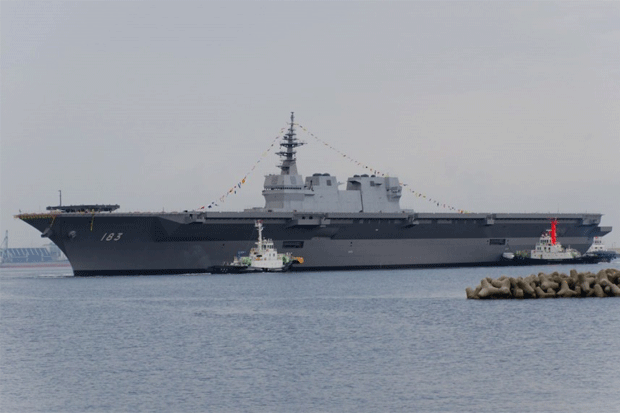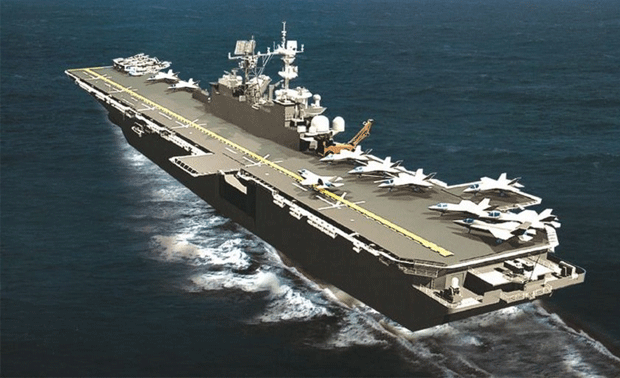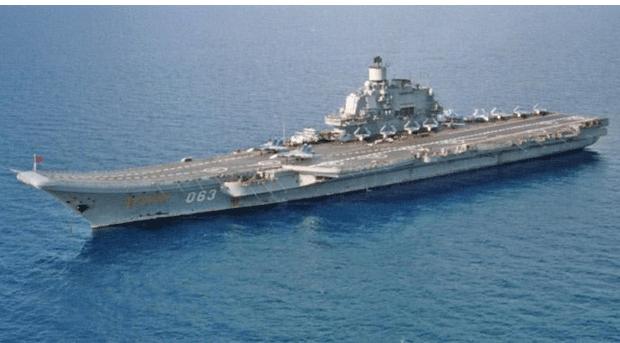|
Having a numerically large navy is a symbol of
wealth and power. It also reflects that nation’s ability to influence
the rest of the world or impose its will on others. With the
introduction of airpower, nuclear weapons and space technology
throughout the 20th Century, the role of the navy changed somewhat. That
said, a capable navy remains an important tool to move your forces
around the world, control an area of water or send a political message
to another state.
Within the navies of the world, an assortment of ships make up the
fleet. From tankers and supply ships to cruisers and aircraft carriers,
navies are composed of a lot of different kinds of vessels.
Unsurprisingly, it’s the big ships that tend to get all the attention.
After all, it is the big ships which tend to have the biggest guns, the
most missiles and the most aircraft. Outside of nuclear weapons, large
naval vessels are the ultimate expression of a country’s power and
ability. The country with the newest and biggest ship usually leaves the
competition scrambling to catch up. A little over 100 years ago, the
British demonstrated this when they built the HMS Dreadnaught, the first
‘modern’ battleship of massive size, speed and armament. It set off an
arms race as every other power desperately moved to build their own
fleet of Dreadnaught style ships. To this day, the powers of the world
have continued to compete to see who could build the biggest, best
armed, most capable and modern warships.
The ships of today dwarf most of the biggest warships built during the
Second World War. In terms of tonnage, even the 72,000 ton Yamato class
battleship of the Imperial Japanese Navy – the largest warship of World
War 2 – falls well short of the 100,000 ton aircraft carriers which have
become the norm in the US Navy. The following list is not about tonnage
but, instead, gives the largest current classes of warships based on
length because in this world, size does matter.
|
|
10. Izumo Class (Japan) – 813 feet
Although only one ship in this class has been completed, Japan plans on
building at least one more for the Japanese Maritime Self-Defense Force.
The Izumo is a helicopter carrier whose main military purpose is to hunt
down enemy submarines and destroy them. It can carry up to 14
helicopters or 400 troops and a few dozen vehicles. Costing
approximately $1.2 billion a piece, the Izumo class are the most modern
ship in the Japanese fleet and the largest that Japan has built since
the Second World War. Other than the sub-hunting helicopters, this class
of warship has no offensive armament and sports only a few short range
guns and surface-to-air missiles for defensive purposes. The Chinese
government has argued that the Izumos could operate more offensive
aircraft, like the F-35 stealth fighter, with little modification. These
claims have been rejected, as such an act would violate the constitution
of Japan which forbids offensive weaponry. |
|
 |
|
9. Kirov Class (Russia) – 827 feet
Unlike the Izumo class, Russia’s nuclear powered battle-cruisers of the
Kirov Class are anything but defensive in purpose. Built and
commissioned between the late 1970s and 1990s, there were only four
vessels of this class built as it is estimated each ship cost well over
the present-day equivalent of $2 billion. Currently, one is fully
operational while the other three are going through a modernization
before being returned to service. The Kirovs are truly impressive in
terms of weaponry. They carry supersonic anti-ship missiles with a range
of 500km, hundreds of surface-to-air missiles to shoot down enemy
missiles and planes, as well as an assortment of anti-submarine
weaponry. The size of these vessels shocked Western observers and
military planners to point where the United States re-activated and
modernized its four World-War Two era Iowa class battleships. |
|

|
|
8. Wasp Class (USA) – 831 feet
During the Second World War, the United States Navy and Marine Corps
learned the importance of having specialized ships and equipment for
getting troops ashore on hostile territory. This requirement has held
true over the decades since and the United States has invested
considerable money into ensuring it has the ships capable of inserting
and supporting forces in hostile areas. From 1989 to 2009, the eight
ships of the Wasp class were commissioned into service at the cost of
around $750 million each. In addition to its 1200 crew, these amphibious
assault ships can carry nearly 1900 marines, dozens of assault craft,
helicopters, tanks and armored assault vehicles. In addition to
supporting operations in the Middle-East and Asia, ships of the Wasp
Class have taken part in humanitarian missions and disaster relief. |
|

|
|
7. America Class (USA) – 844 feet
Like the Wasp Class, the America Class is a type of amphibious assault
vessel used by the United States. The USS America, the first of this
newest class of ship, is larger, more modern and, at $3.4 billion, much
more expensive than those of the preceding class. Much of this cost
increase is a result of ensuring that these new assault ships can
operate larger and newer aircraft, such as the F-35 Lightning II stealth
fighter and the MV-22 Osprey transport. This makes the new America class
ships nearly as capable as a small aircraft carrier. In terms of
airpower, depending on the mission being undertaken, these ships also
carry an assortment of transport, assault and attack helicopters. All of
this is in addition to nearly 1,700 marines, tanks, artillery and other
vehicles which can be carried. |
|
 |
|
6. Charles de Gaulle Class (France) – 858 feet
So far the only ship in her class, the aircraft carrier Charles de
Gaulle is the first nuclear powered French surface ship and the only
nuclear powered carrier currently deployed outside of the US Navy. After
considerable delay and economic slowdowns, the carrier was finally
commissioned in 2001 at the cost of approximately $4 billion. In
addition to light guns and missiles for defense, this French carrier can
operate 40 aircraft and sail for over 20 years before it needs
refueling. The Charles de Gaulle has faced its challenges, including
broken propellers, poor construction, high radioactivity from the
reactors and a flight deck that was initially too short to operate the
desired aircraft. Nonetheless, once the kinks were worked out, the
carrier took part in operations around the world, including the war
against the Taliban in Afghanistan.
|
|
 |
|
5. Modified-Clemenceau Class (Brazil) – 869 feet
From 1961 to 2000, the French Navy operated two of the Clemenceau class
aircraft carriers. When the time came for France to modernize, one ship
was scrapped while the other (Foch) was sold to the Brazilian Navy in
2000 for $12 million. The Foch was renamed São Paulo. Since its
purchase, the São Paulo has undergone numerous and extensive upgrades to
its flight-deck, engines, sensors and defensive weaponry.
Unsurprisingly, most of these enhancements have been provided by French
companies. It hasn’t been smooth sailing for the São Paulo since its
introduction to the Brazilian Navy. In 2005 and 2012 fires broke out
onboard the ship, killing and injuring a number of crewman. Currently,
the ship can carry 39 aircraft with the A-4 Skyhawk providing the
offensive capability.
|
|
 |
|
4. Modified-Kiev Class (India) – 930 feet
The INS Vikramaditya is currently one of two aircraft carriers in the
Indian Navy. The ship began its life as the Baku in the Soviet Navy in
1987. By 1996, Russia decided that its budget could not support a
Soviet-era military and the country moved to scrap or sell a
considerable amount of military equipment. In 2004, the Baku was
purchased by India for $2.35 billion. As part of the deal, Russia agreed
to modify the ship to Indian needs and equip it with Russian aircraft.
These changes included stripping the heavy armament and adding a
ski-jump ramp at the end of the flight deck to transform the Soviet-era
cruiser-carrier into a full aircraft carrier. In 2013, the carrier was
commissioned into the Indian Navy as the INS Vikramaditya with the
capability to operate 36 aircraft.
|
|
 |
|
3. Modified-Admiral Kuznetsov Class (China) – 999
feet
The PLAN Liaoning is the first aircraft carrier to enter service with
China. The ship was originally named the Riga during its time in Soviet
service. Renamed Varyag in 1990, the carrier was deemed surplus to
Russia needs as it no longer fit with the Russian post-Soviet military
budget. China purchased the stripped down carrier from Ukraine in 1998
for $25 million under the story that it would be turned into a floating
casino. Everyone knew such a cover-story was ridiculous and military
analysts were not surprised when the carrier was commissioned into
Chinese service as the Liaoning in 2012. The carrier is fitted with
defenses against missiles, aircraft and submarines, as well as the
ability to operate 30 fixed wing aircraft. As the Liaoning is China’s
first carrier, it is primarily used to train pilots for carrier service. |
|
 |
|
2. Admiral Kuznetsov Class (Russia) – 1001 feet
Unlike American aircraft carriers, Soviet-Russian aircraft carriers were
often equipped with heavy offensive-defensive weaponry. This weaponry
includes heavy long-range anti-ship missiles, dozens (if not hundreds)
of SAMs and some form of anti-submarine weaponry – all in addition to
the aircraft they carried. The Admiral Kuznetsov class fit this formula
well and is considered to actually be a Heavy-Aircraft-Carrying-Cruiser.
The Admiral Kuznetsov is the only remaining ship of this class – the
other being sold to China. This carrier was commissioned into service in
1990 and remains Russia’s only true aircraft carrier. In terms of
aircraft, the Admiral Kuznetsov can operate over 30 fixed wing aircraft
and a dozen helicopters.
|
|
 |
|
1. Nimitz Class (USA) – 1092 feet
The aircraft carriers of the Nimitz Class are the largest warships
currently in service in the world. At around $4.5 billion each, these
carriers are the most expensive ship on this list. The ten ships of this
class help the United States flex its military muscle around the world.
Aside from military matters, these 100,000 ton super-carriers have also
provided humanitarian relief from the Indonesian tsunami in 2004 to the
2010 earthquake in Haiti.
Nimitz carriers can operate 85 to 90 aircraft, substantially more than
any other carrier in the world. They also have the usual array of
missiles and guns meant to protect against enemy missiles and aircraft.
It is expected that each carrier from this class will serve for 50 years
before being decommissioned. In the meantime, the US Navy has already
begun the building the Gerald R. Ford class, an even bigger aircraft
carrier with a price tag estimated to be between $9-12 billion. |
|
 |